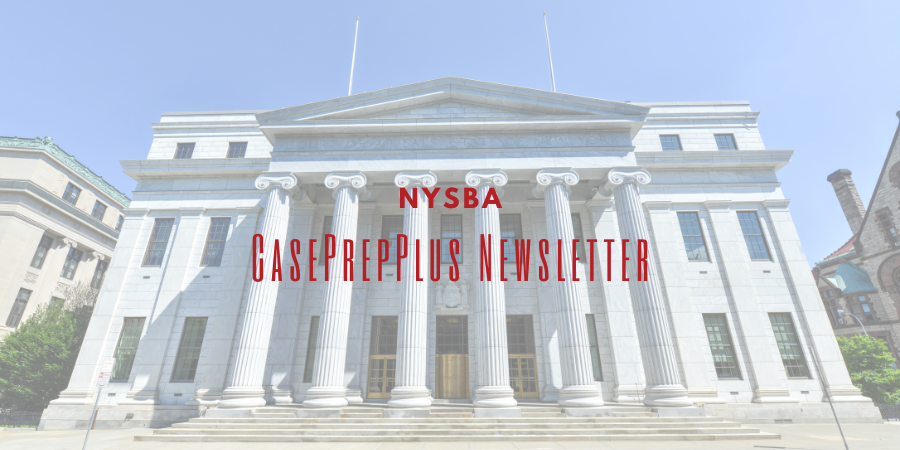
Newsletter 1.5.24: Is the Use of a Police Dog to Sniff a Person for Concealed Drugs a Search under the Fourth Amendment?
Happy New Year! Let’s take a look what has been happening in New York’s appellate courts over the past week.
Court of Appeals
People v Butler, 2023 NY Slip Op 06468 (Ct App Dec. 19, 2023)
Criminal Law
Issue: Does the use of a canine to detect the scent of illegal drugs concealed on a person’s body qualify as a search within the meaning of the Fourth Amendment to the U.S. Constitution?
Facts: After observing the defendant make what they believed was a hand-to-hand drug sale, the police followed the defendant’s vehicle and stopped him when he failed to stop at a stop sign. During the stop, the defendant exited the vehicle and declined to consent to a search. The police then retrieved a drug-sniffing dog, which alerted in the defendant’s direction, before sniffing the car and alerting again. Following the second alert, the officers decided to let the dog investigate the defendant’s person. “He ‘extended the leash a little bit’ so the canine could walk around defendant, at which point the dog indicated for the third time that it was in odor, put its nose in defendant’s ‘groin/buttock region,’ and sat, alerting the officer that it had located narcotics. When the officer stated that ‘[t]he dog has got something,’ defendant ran.” The police apprehended him and recovered a bag of heroin from the area, after defendant had discarded it during his flight. Defendant moved to suppress the drugs, arguing that the dog sniff of his vehicle and person was an unlawful search. County Court held that the sniff wasn’t a search under the Fourth Amendment, and denied the motion. The Appellate Division, in a divided opinion, held that the dog sniff was a search, but “that this type of search requires reasonable suspicion of criminal activity because a canine sniff is a minimal intrusion compared to a full-blown search of a person” and that the search wasn’t unreasonable under the circumstances.
Holding: After a review of the U.S. Supreme Court’s precedent on “the use of drug-sniffing dogs by law enforcement in other contexts,” the Court of Appeals held that “the use of a canine to sniff defendant’s body for the presence of narcotics qualified as a search.” The Court reasoned, “[i]t cannot be disputed that society treats many matters related to the body as private, or that individuals have a significant interest in the security and integrity of their persons. The Fourth Amendment protects those important interests from unreasonable intrusion by the government. . . . Thus, the Supreme Court has long held that the Fourth Amendment is implicated when the government attempts to gather evidence of criminal activity from an individual’s person. . . . [T]he presence or absence of direct physical contact with the body is not determinative of whether or not government conduct implicates ‘[t]he right of the people to be secure in their persons’ and qualifies as a search; the question turns instead on whether the conduct compromises personal dignity and violates reasonable social expectations concerning the security of one’s body and the privacy of matters related thereto. . . . Compared to a sniff of an inanimate object like a closed suitcase or automobile, the sniffing of the human body involves an obviously greater intrusion on personal privacy, security, and dignity. Most people ‘deliberately attempt not to expose the odors emanating from their bodies to public smell’ and experience anxiety and embarrassment at the thought of emitting odors, demonstrating the sensitivity of the matter.” Thus, the Court held, the police allowing the dog to sniff the defendant for evidence of drugs intruded upon his expectation of privacy and constituted a search under the Fourth Amendment. Because the County Court had not addressed any other question in the case, section 470.15 (1) of the Criminal Procedure Law foreclosed the Appellate Division from exercising jurisdiction to decide that reasonable suspicion was required and the search was justified. The Court of Appeals thus remanded the case to County Court to allow that court to decide those issues in the first instance.
Freedom of Information Law, Attorney-Client Privilege
Issue: Do documents prepared by counsel to an administrative agency for the purpose of training and advising the agency and its members on how to comply with their legal duties and obligations qualify for the attorney-client privilege exemption from disclosure under the Freedom of Information Law?
Facts: Appellate Advocates filed a FOIL request with DOCCS for public records related to the Board of Parole’s decision-making process. DOCCS disclosed thousands of pages of documents, but withheld 11 documents, asserting that they were privileged attorney-client communications because they were prepared by counsel for training and advising Board of Parole commissioners on how to comply with their legal obligations in deciding parole applications. The courts rejected Appellate Advocates challenge to the partial FOIL denial.
Holding: Noting that the proper inquiry focuses on whether the lawyer’s communications were “made in order to render legal advice or services to the client,” the Court of Appeals held that the training materials clearly fell within the scope of attorney-client privileged material. The Court reasoned that, “[t]he documents contain counsel’s advice regarding compliance with legal requirements concerning parole interviews and parole determinations, including as applied to persons designated as minor offenders. The documents summarize recent court decisions and advise on how to apply statutes, regulations, and case law to parole determinations. The documents also include guidance on drafting parole decisions that accord with the law. In sum, the documents reflect counsel’s legal analysis of statutory, regulatory and decisional law, and provide guidance for the commissioners on how to exercise their discretionary authority. Therefore, the documents are privileged and fall squarely within the exemption under Section 87 (2) (a).”
Appellate Division, First Department
People v National Rifle Assn. of Am., 2023 NY Slip Op 06819 (1st Dept Dec. 28, 2023)
Constitutional Law
Issue: Did Supreme Court properly dismiss the National Rifle Association’s counterclaims against the New York Attorney General for First Amendment retaliation and selective enforcement in bringing a suit to dissolve the NRA for widespread and longstanding executive malfeasance?
Facts: The New York Attorney General sued the NRA, a not-for-profit corporation, seeking dissolution, alleging “widespread and longstanding executive malfeasance,” including, for example, regularly paying for enormous expenses incurred by its executives and their family members for personal travel to the Bahamas, often via private jet, and to other destinations, among other things. The NRA filed counterclaims, alleging First Amendment retaliation and selective enforcement based on statements that the AG made while campaigning that she would “take down the NRA” using her power as attorney general to regulate charities. The AG moved to dismiss, and Supreme Court dismissed the counterclaims because the First Amendment retaliation claim failed to allege a causal connection and the selective enforcement claim failed to allege a similarly situated charity that was treated differently and the AG showed it had previously sought dissolution of other charities.
Holding: The First Department affirmed. The Court held, on an issue of first impressions, that “the proper legal standard applicable to First Amendment retaliation claims in civil enforcement proceedings such as this one is the no probable cause standard articulated in” the U.S. Supreme Court’s decisions in Hartman v Moore (547 US 250 [2006]) and Nieves v Bartlett (587 US ____, 139 S Ct 1715 [2019]). Under that standard, because the AG had probable cause to investigate the NRA’s actions, its First Amendment retaliation claim was properly dismissed. Finally, the First Department held that dismissal of the selective enforcement claims was proper because the counterclaims failed to allege that the other charities that the AG chose not to seek to dissolve to resolve allegations of executive misconduct were similarly situated to the NRA. In each case, those charities agreed to overhaul their executive leadership to remove the individuals who had committed the alleged misconduct, whereas the NRA refused to do so.
Appellate Division, Second Department
A.G. v Roosevelt Union Free Sch. Dist., 2023 NY Slip Op 06727 (2d Dept Dec. 27, 2023)
C.P.G. v Uniondale Sch. Dist., 2023 NY Slip Op 06512 (2d Dept Dec. 20, 2023)
Torts, Assumption of the Risk
Issue: In what circumstances do infant plaintiffs assume the risks inherent in participating in school activities and are thus barred from recovering damages from their school districts for injuries suffered during those activities?
Facts: In A.G., the plaintiff was a middle school student, who was injured during rehearsal for the school’s extracurricular musical theater production when she struck her toe on a metal anchor affixed to the stage, while running to meet her musical cue. In C.P.G., the plaintiff was an eighth grade student, who was injured while playing a “pickup” game of soccer on a field at the school during a school-sponsored event.
Holding: The Second Department held that “[u]nder the doctrine of primary assumption of risk, a voluntary participant in a sporting or recreational activity consents to those commonly appreciated risks that are inherent in and arise out of the nature of the sport generally and flow from participation therein. It is not necessary to the application of assumption of risk that the injured plaintiff have foreseen the exact manner in which his or her injury occurred, so long as he or she is aware of the potential for injury of the mechanism from which the injury results. A participant is not, however, deemed to have assumed risks that are concealed or unreasonably enhanced.” In A.G., the Court held that questions of fact precluded summary judgment to the school because there was evidence that put into question whether the anchor on the stage, as covered by stage curtains, on which the infant plaintiff struck her toe, constituted a concealed risk. In C.P.G., in contrast, the Court held that the infant plaintiff’s fall from “pebbles on the field and wet and muddy grass” did not “present[] a concealed or unreasonably increased risk beyond those inherent in the activity of outdoor soccer, regardless of whether the wet grass was caused by rain or water balloons” from a school event the day before.
Social Services, Religious Education
Issue: Does an early childhood education program for Jewish girls require a license under Social Services Law § 390?
Facts: Shulamith School for Girls operates an early childhood program for Jewish girls aged three to five in Woodmere. The New York State Office of Children and Family Services determined that the early childhood program was a child day care center required to be licensed under Social Services Law § 390, and issued the school a letter directing it to cease and desist its unlicensed operation of a child day care center.
Holding: The Second Department held that two exceptions exist to the licensure requirement for child day care centers: (1) when the program is for school-aged children and provides solely religious instruction and (2) when the program is for pre-school children and is operated by a public or private school on the same premises or campus at which its elementary or secondary school is operated. Here, the Second Department held that OCFS’ interpretation of the term “school-aged children” to exclude the early childhood students at the school, even though they were receiving religious instruction, was supported by the statute. Additionally, the school did not qualify for an exemption from the licensure requirement under the second exception either, because the program was not located on the same campus as the private school’s elementary and secondary schools, which was approximately 1.3 miles away. Thus, the Second Department confirmed the OCFS determination.
Appellate Division, Third Department
Tax Law
Issue: Was it rational for the Tax Appeals Tribunal in interpreting Tax Law § 16 (f) (2) (C) to require the application of the business allocation percentage to determine what portion of the petitioners’ income was “allocated within the state” for purposes of calculating petitioners’ qualified empire zone enterprise credit?
Facts: Tax law is complicated. That’s what I learned from reading this case. Qualified empire zone enterprise (“QEZE”) tax reduction credits were offered for businesses that manufacture goods in New York’s Empire Zones and could be claimed on the personal income taxes of the owner of such a pass-through entity. In Schreiber and Goldstein, the owners of B & H Foto & Electronic Corporation claimed the QEZE credits, the amount of which is “derived from four factors: (1) the benefit period factor; (2) the employment increase factor; (3) the zone allocation factor; and (4) the tax factor. Only the tax factor, which is a dollar amount based upon the tax imposed by New York law on the taxpayer that is attributable to the corporation’s income, is at issue here. The tax factor for a shareholder of a New York S corporation that is claiming a QEZE credit is the portion of a shareholder’s total New York income tax that is equal to ‘the ratio of the shareholder’s income from the S corporation allocated within the state, entering into New York adjusted gross income, to the shareholder’s New York adjusted gross income.’” Even though B&H sold goods and derived income from out of the state, the owners claimed the credit for all of the business’s income. The Division of Taxation determined that this was improper, and that that the owners’ tax factor had to be multiplied by the B&H’s business allocation percentage to determine what portion of the income was “allocated within the state.” The Tax Appeals Tribunal agreed.
Holding: The Third Department reversed, holding that its prior decision in Matter of Purcell v New York State Tax Appeals Trib. (167 AD3d 1101 [3d Dept 2018]) did not here require application of the business allocation percentage to determine what portion of the business’s income was “allocated within the state” because B&H did not have any operations outside of the state in the tax year at issue. Although B&H made significant sales outside of New York, all of its economic activity—offices, jobs, etc.—were from within the Empire Zone. A reduction of its QEZE credit therefore was contrary to the very purposes of the credit in the first place: “The purpose of the Empire Zones Program is to provide “special incentives and assistance that will promote the development of new businesses, the expansion of existing businesses and the development of human resources” in “certain areas characterized by persistent and pervasive poverty, high unemployment, limited job creation, a dependence on public assistance income, dilapidated and abandoned industrial and commercial facilities and shrinking tax bases” (General Municipal Law § 956). Certainly, the Empire Zones Program is most successful if businesses within QEZEs are successful and generate robust business, bringing not only money into the area, but jobs as well. To then limit those entities from realizing the full benefit of that robust business by restricting the QEZE credit to only sales with an end destination in New York is illogical and contrary to the statutory purpose.”
Appellate Division, Fourth Department
Arnold v Town of Camillus, 2023 NY Slip Op 06627 (4th Dept Dec. 22, 2023)
Discrimination, Notice of Claim
Issue: Is a plaintiff required to file a notice of claim for Human Rights Law discrimination claims against a Town police department?
Facts: A police officer previously employed by the Town of Camillus sued alleging that defendants violated the Human Rights Law (Executive Law § 290 et seq.) by discriminating against her on the basis of gender, subjecting her to a hostile work environment, constructively discharging her from employment, and retaliating against her after she complained about the alleged unlawful discriminatory practices. She did not serve a notice of claim before doing so. When she filed the complaint, the plaintiff moved for a “declaration” that she was not required to serve a notice of claim for her Human Rights Law claims, as well as for leave to serve a late notice of claim regarding her state law tort claims and, if required, her Human Rights Law claims. Supreme Court denied the motion.
Holding: The Fourth Department held that although the Court of Appeals’ decision in Margerum v City of Buffalo (24 NY3d 721 [2015]) held that a claim under the Human Rights Law does not require a notice of claim pursuant to General Municipal Law §§ 50-e and 50-i, that did not similarly exempt the plaintiff from compliance with Town Law § 67’s notice of claim requirement, which is broader than the requirements under the General Municipal Law. As the Court explained, “the language of Town Law § 67 is still broader than its General Municipal Law counterpart because it also includes any claim against a town defendant for damages for a ‘wrong . . . to person’ (Town Law § 67 [1]). Consistent with the purpose of the Human Rights Law, unlawful discrimination and retaliation is undoubtably considered a wrong against a person (see Executive Law § 290 [3]). Thus, the plain, unambiguous text of Town Law § 67 directs that a notice of claim is required for an action alleging violations of the Human Rights Law.”

